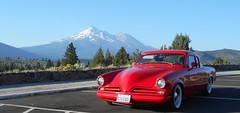Too cold to work on the Stude today (unheated garage)so went to continue purging junk downstairs to satisfy Mrs. Junior...got sidetracked going through an old Scholastic book `Stock Bodied Drag Racing` by Lyle Engel and the staff of Auto Racing Magazine. I think I got this book in grade 6, about 1970. A few references to Studebaker, even two about none other then Ted Harbit`s stock records. The one I found most interesting was this on page 31: `The sharp racers don`t let style or age influence a decision on class breaks, shipping weights etc. Currently they favor the following cars for winning Stock Eliminator performance:1954 308-inch Hudsons,1951-1954 Studebaker v-8`s...` Anyone know what was special about the Studebaker V8s from this specific time period...or was it the weight of the cars, even though there was quite a variance in body styles? Seems weird that in 1970, a 51 Studebaker would still be competitive in a Stock class let alone being favoured as a class winner. What do ya figure?? Junior.
Announcement
Collapse
No announcement yet.
I wonder how come...the author states:
Collapse
X
-
I would think that there was a favorable hp-weight ratio on the cars in question. There is a chance that a sharp tuner could get those motors to perform better than the factory horsepower rating. Because of the way classes were calculated, weight to HP, there was a range within the class. You can see typical weight breaks here: http://classracer.com/classes.html. Cars could fall near the top, in the middle or at the bottom of the weight class. Back "in the day" there were a number of cars, like convertibles, 4 doors or even wagons, that hit the class right at the edge and those cars had an advantage over others. Sometimes NHRA would determine that certain engines were under rated as far as HP was concerned and they would factor their HP rating up and that would put them up into the next class.Pat Dilling
Olivehurst, CA
Custom '53 Starlight aka STU COOL

LS1 Engine Swap Journal: http://www.hotrodders.com/forum/jour...ournalid=33611
-
Thanks guys. Does that mean that Ted Harbit was still competitive with the Chicken Hawk in pure stock classes in the early 70`s...and if so, were other Studes competitive as well? I clearly remember John Dianna from Hot Rod mag. competively running longroofed tri-five Chevys with 283`s because of this. Regards, Junior.sigpic
1954 C5 Hamilton car.
Comment
Comment